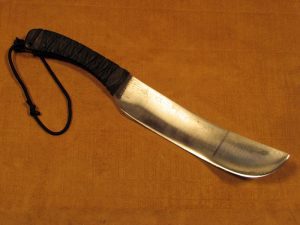 The American Bladesmith Society was founded to promote the art and science of the forged blade. It provides resources for bladesmithing students, as well as a rating system for smiths and standardized testing for the achievement of those ratings.
The American Bladesmith Society was founded to promote the art and science of the forged blade. It provides resources for bladesmithing students, as well as a rating system for smiths and standardized testing for the achievement of those ratings.
The earned ratings are Journeyman Smith and Master Smith. There is also an Apprentice Smith rating, but it serves as a starting point and is not earned.
The test for each rating is divided into two major parts: performance and presentation. The performance test assesses the candidate’s ability to create one blade capable of meeting or exceeding an established set of physical performance standards.
The presentation test measures the candidate’s ability to make five knives that meet a set of standards based on fit, finish, and practical as well as aesthetic design. These knives must also be fully functional, but are not tested in the same ways as the performance blade is.
All knives must be forged.
My Performance Test
This past winter, I took and passed the performance part of my Journeyman Smith test, and I recorded the test so that I could share it with my fellow kobolds.
As far as making the knife, we’ve already talked about all the steps and components that go into a blade that can stand up to this test. We talked about heat treating steel in The Mystery of Steel—Magic and Magnetism, blade geometry in Edge Geometry, properties of various steel alloys in Steel Types and Properties, and hamon and differential hardening in The Katana.
What the Test Covers
Officially, from the ABS site, but I edited for brevity:
- ROPE CUTTING: THE PURPOSE OF THIS TEST IS TO TEST THE EDGE GEOMETRY AND SHARPNESS. The applicant must cleanly cut a 1” diameter, free hanging, manila or hemp rope.
- WOOD CHOPPING: THE PURPOSE OF THIS TEST IS TO DEMONSTRATE EDGE TOUGHNESS. The applicant must cut through a construction grade 2×4, twice, and the edge must not deform, roll, or flatten.
- SHAVING HAIR: THE PURPOSE OF THIS TEST IS TO DEMONSTRATE EDGE RETENTION. The applicant must shave hair using the section of the blade that was most frequently used in the cutting and chopping portions of the test.
- BENDING: THE PURPOSE OF THIS TEST IS TO SHOW THAT THE APPLICANT IS ABLE TO HEAT TREAT A KNIFE WITH A SOFT BACK AND A HARD EDGE. The knife is placed in a vise approximately 1/3 of the blade length from the tip. The blade must then be bent to 90° without cracking more than 1/3 the width of the blade. The blade may not chip and the tang may not break off. The blade may take a set (a bend that does not spring back).
The Presentation Test Knives
After passing the performance test, the applicant has three years to present the knives to be judged for the presentation part of the test.
For the Journeyman rating, the workmanship of the knives is to be of “very good to excellent” quality. It’s somewhat subjective, but essentially the surface finish needs to be uniform and free of scratches (they don’t need to be a mirror finish, but there must be only the intended, unidirectional scratch pattern, with no errant scratches), and all the parts should fit together neatly and without gaps. All parts must be attached at the correct angles (i.e., the guard may not slope from side to side), and the knife must feel comfortable in the hand and be pleasing to the eye.
My Presentation Knives
I intended to present my knives on 06/05/15 at the Blade Show in Atlanta, but for a variety of reasons I decided to wait until next year. The good thing about that is that I now have a second opportunity to document the process, and share it here.
How This Applies to Gaming
In my opinion, a knife of Journeyman quality equates in various gaming systems to a “masterwork” blade; it is born of superior, tested workmanship and made from high-quality materials. A small utility knife of this quality takes a skilled maker 20-25 hours to complete. A large fighting knife may take 40-60 hours. A sword may take hundreds.
I hope you can take this information and use it to better understand the value of well-made edged weapons and tools in your game (and in real life, for that matter). Perhaps a particular sword isn’t so easy to sunder, or perhaps it is better at sundering. “Keen” can be due to physical properties, rather than an enchantment. A poignard may have an especially acute point, perhaps a “blade of piercing.” You’re gamers—you know where I’m going with this.
Here’s the YouTube video for further information!

Congrats Todd!
Video is pretty awesome, that knife kept on trucking (and shaving) :-)
Thanks, Darkjoy. It’s turning into quite a journey.